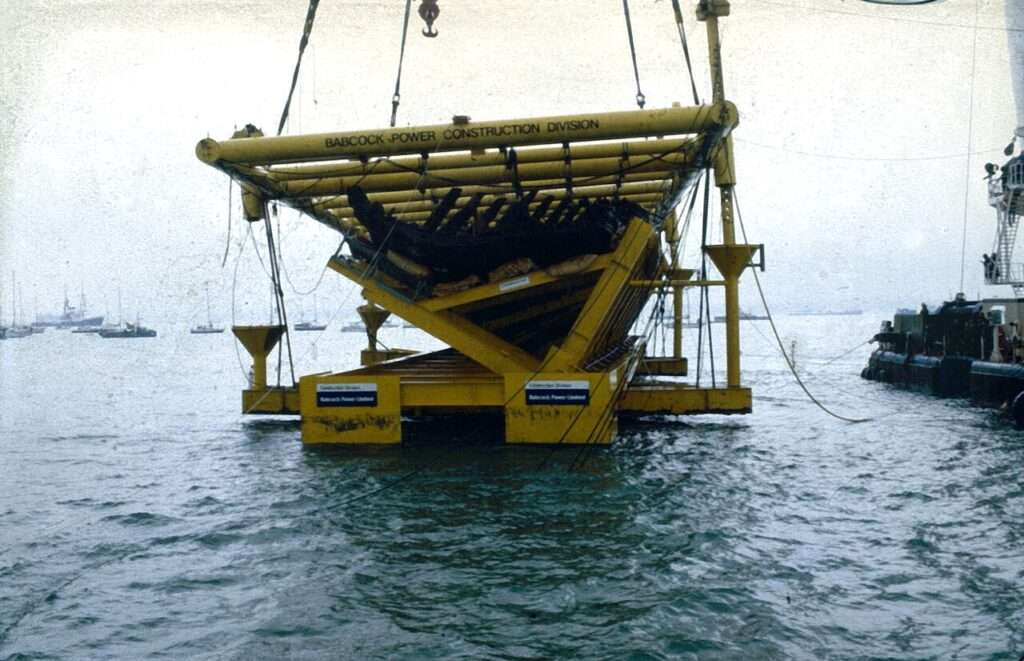The Mary Rose, a remarkable relic of British maritime history, provides a snapshot into the world of Tudor naval warfare, technology, and daily life.

This warship, famously associated with King Henry VIII’s navy, sank in 1545, only to be rediscovered and recovered in 1982, unveiling a trove of invaluable historical artifacts and unprecedented details about 16th-century maritime life.
Construction And Service Of The Mary Rose
The construction of the Mary Rose represented a significant milestone in the evolution of naval architecture and warfare during the early 16th century.
Commissioned by King Henry VIII, the construction commenced in 1509, in Portsmouth, which was one of England’s primary naval dockyards.
She was built using advanced design and construction techniques of the time, which resulted in a sturdy, versatile, and powerful warship.
A strong oak frame provided the core structure, while the hull, made from elm, was clinker-built – a method that overlapped the wooden planks to provide strength and watertight integrity.
The design of the Mary Rose reflected an important shift in naval warfare.
She was one of the first English warships designed to carry a battery of heavy guns, marking a significant transition from warfare that primarily involved boarding and hand-to-hand combat to warfare that relied more on artillery power.
These guns were placed on the lower deck, a new practice that allowed for a broadside attack, maximizing the impact on enemy ships.
 The Mary Rose depicted by Anthony Roll.
The Mary Rose depicted by Anthony Roll.
Named after Henry VIII’s favourite sister, Mary Tudor, and the emblem of the Tudor dynasty, the Rose, the Mary Rose was not just a warship but also a symbol of the growing naval power and prestige of Tudor England.
The ship was approximately 38.5 metres in length, with a breadth of about 11.7 metres, representing a considerable size for its era.
Throughout her operational life, the ship served prominently in several naval conflicts against France, reflecting the ongoing power struggles between these two European powers.
She took part in significant naval engagements, such as the Battle of the Saintes in 1512 and the Battle of the Solent in 1545.
The Battle of the Solent, however, marked the end of her service. In a tragic event that is still shrouded in mystery, the ship sank during this battle.
Some historical accounts suggest that a strong gust of wind caught her sails while her gun ports were open, which made her lean heavily to one side, take on water, and ultimately sink.
Despite the loss, the legacy continued, preserved under the Solent’s seabed for more than four centuries before her rediscovery.
Recovery Of The Mary Rose
The discovery and recovery of the Mary Rose, over four centuries after she had sunk, represented one of the most significant archaeological operations of the 20th century.
The idea to search for the Mary Rose began to take shape in the late 1960s, and marine archaeologist Alexander McKee initiated the project.
McKee’s plan, named ‘Project Solent Ships’, aimed at finding, excavating, and recovering shipwrecks from the Solent, the strait separating mainland England from the Isle of Wight.
The search for the ship was not straightforward. The silt of the Solent had hidden her remains for centuries, and the technology of the time did not facilitate easy underwater exploration.
 Recovery of the Mary Rose, 11 October 1982. Image by The Mary Rose Trust CC BY-SA 3.0
Recovery of the Mary Rose, 11 October 1982. Image by The Mary Rose Trust CC BY-SA 3.0
Nonetheless, McKee and his team deployed cutting-edge methods, including underwater archaeology and geophysical surveys, which were groundbreaking for the era.
The endeavour required numerous dives, underwater surveys, and careful archaeological documentation.
In 1971, the location of the Mary Rose was confirmed, marking a significant breakthrough.
However, the full excavation and recovery would take over a decade more.
In 1982, following painstaking excavation work, the remains of the Mary Rose were finally raised from the seabed in a delicate operation that captured the public imagination.
The ship was lifted using a cradle and a complex system of divers, lifting wires, and flotation bags.
Millions watched on television as the Mary Rose was carefully brought to the surface, marking a pivotal moment in maritime archaeology.
However, the recovery of the Mary Rose was not only about the ship itself. It also encompassed the thousands of artefacts within the ship, preserved remarkably well in the seabed’s environment.
 The Mary Rose out of the water. Image by The Mary Rose Trust CC BY-SA 3.0
The Mary Rose out of the water. Image by The Mary Rose Trust CC BY-SA 3.0
When Was the Mary Rose First Discovered?
On the 1st of May, 1971, Percy Ackland found the Mary Rose. In that diving session, he came across three of its port frames.
This was 11 years after marine archaeologist Alexander Mckee’s team began the search for this ship.
It would take until 1978 for divers to prove two decks survived and another for excavation plans to begin.
Artefacts
The recovery of the Mary Rose unearthed a treasure trove of over 19,000 artefacts, each providing a unique glimpse into Tudor life and naval warfare.
What makes the Mary Rose unique compared to other archaeological sites is the extraordinary range and preservation of these items, which were shielded from decay by the silty seabed of the Solent.
A remarkable collection of Tudor weaponry was found on the ship. Among these were longbows and several thousand arrows. The longbows recovered are among the best-preserved examples in the world.
Other arms included guns of various sizes, from large bronze and wrought iron cannons to handheld firearms.
However, the artefacts recovered weren’t just limited to warfare.
A vast array of personal belongings were found, deeply humanizing the crew members who served on the ship.
Items such as combs, shoes, garments, and even musical instruments were among the personal effects recovered, allowing archaeologists and historians to gain an in-depth understanding of the living conditions and personal life of the crew.
Intriguingly, some artefacts provided insights into the recreational activities of the crew.
For instance, dice and a backgammon set were discovered, suggesting that such games were used by sailors to pass the time during long voyages.
Similarly, the ship’s galley yielded cooking pots, bowls, and utensils.
 Wooden bowls found on the Mary Rose. Image by The Mary Rose Trust CC BY-SA 3.0
Wooden bowls found on the Mary Rose. Image by The Mary Rose Trust CC BY-SA 3.0
Among the many artefacts was also the ship’s dog, affectionately named ‘Hatch’ by the archaeologists. Hatch, likely a ratter to control vermin on the ship.
These artefacts together serve as a time capsule, providing an unrivalled look into Tudor life.
They highlight not only the aspects of war but also the daily lives, personal habits, and even leisure activities of the people of that era, turning the Mary Rose into a floating microcosm of 16th-century England.
Conservation and Display Of The Mary Rose
The raising of the Mary Rose from her watery grave marked the beginning of another significant and meticulous phase of the project – her conservation.
When a wooden ship sinks and spends centuries underwater, the water replaces the air within the wooden cells, which, if allowed to evaporate, would cause the wood to shrink, distort, and collapse.
Consequently, she required a highly careful conservation process to prevent the deterioration of its structure and the invaluable artefacts it housed.
For over a decade after the raising of the ship, the hull was continuously sprayed with chilled freshwater to remove the salts that had accumulated over the centuries in the Solent’s saltwater environment.
This desalination process was crucial to prevent the crystallization and expansion of salt, which could cause significant damage to the wood’s cellular structure.
 During the conservation process. Image by The Mary Rose Trust CC BY-SA 3.0
During the conservation process. Image by The Mary Rose Trust CC BY-SA 3.0
Following desalination, the ship underwent a process of impregnation with polyethylene glycol (PEG), a polymer that replaces the water in the wooden cells and provides structural support as the wood dries. This technique, which started in 1994, lasted for almost two decades.
The drying phase, which began in 2013, was the final major step in the conservation process.
The hull was enclosed in a purpose-built drying chamber, and the temperature and humidity were carefully controlled to ensure a slow and safe drying process.
Today, the Mary Rose is housed in a state-of-the-art museum in Portsmouth’s Historic Dockyard.
The ship is displayed in a manner that allows visitors to observe and appreciate the scale and complexity of the ship and its conserved artefacts.
The museum showcases the artefacts in various themed galleries, telling the story of the ship, its crew, and its era, thereby making her more than just a ship but a time capsule of Tudor life.
In conclusion, the recovery and conservation of the Mary Rose represent a significant achievement in the field of marine archaeology.
It underscores the importance of interdisciplinary approaches in heritage conservation, merging science, history, and technology to safeguard our shared past for future generations.





